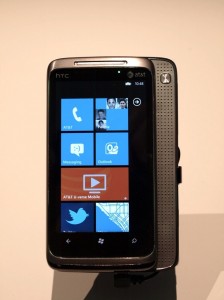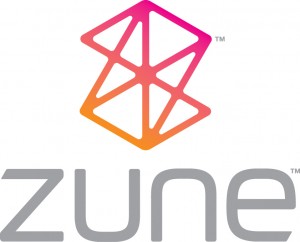After using an iPhone 3G for about 2 years, I gave it up last week. Then, this week, I picked up one of the new Windows Phone 7 devices (the HTC Surround). Following is a brief comparison of the two from my perspective.
 Buying Apps
Buying Apps
The iPhone has the famous App Store, Windows Phone has the Marketplace. While the iPhone obviously has exponentially more apps available than Windows Phone does, a lot of the major apps were available for Windows Phone from day-one. I can’t, in good conscience, say that the Windows Phone Marketplace even compares to the iPhone app store in terms of apps, yet, but things do look good for such a new system.
Both systems allow you to buy/download apps through your computer or through your device, so they are basically equal in that regard. I do think that the Windows Phone will need to find a better way to arrange and organize the apps and games once the marketplace starts to really take off, though.
One place the iPhone has the Windows Phone beat, hands-down, right now is the fact that you can’t view what apps you currently have on your Windows Phone when using your PC. You can only view and manage your apps through the phone.
Interface
The iPhone interface was revolutionary when it came out, but it’s become old after a while, and a lot of flaws have become apparent. It’s difficult to arrange the icons on your iPhone; there’s no real method of organization and it’s actually somewhat clumsy.
On the Windows Phone, it’s a little more simple (in my humble opinion; I am well aware of the fact that people will disagree with me vehmently). You have one home screen and can pin as few or as many apps to that home screen as you choose. Almost anything can be pinned to the home screen. If you need something that’s not pinned to your home screen, you tap an arrow and get to view the full list of apps on your phone. One minor complaint I have about this is the fact that there doesn’t seem to be a way to search for the apps you have installed (clicking the search icon while viewing your app list takes you to Bing to search the Web).
 Media
Media
I realize this is probably an argument similar to the old VHS vs. BetaMax (if you’re old enough to remember that) or, a little closer to my heart, the Sega Dreamcast vs. Sony Playstation 2 argument; but the Zune media player interface is superior to the iPod/iPhone interface. Everyone I know that’s tried a ZuneHD and an iPhone/iPod has said they think so. The iPhone/iPod is so ingrained in the world culture, though, that it will probably forever beat the Zune/Windows Phone simply because of that fact.
That said, the Windows Phone does everything the ZuneHD does, and it does it just as well. The interface is extremely simple to use and works beautifully.
One more thing the Windows Phone has, because it is integrated with the Zune interface, that the iPhone does not is the Zune Pass. If my kids are any indication of the way trends are moving in the world, people are buying less and less music to actually keep. They want to download new songs right now (note I said “songs” not “albums”; apparently nobody buys albums anymore), but in another few weeks they won’t even remember why they liked it in the first place. The Zune Pass is perfect for users like that. You pay one flat rate ($14.99/month or $149.99/year) and you can listen to as much music as you want for a month. When that month is over, you can download 10 songs to keep forever, and the rest basically get thrown in the trash.
If I were to add up all of the money my step-daughter has spent needlessly on iTunes buying songs that she listened to for only a few days; I guarantee the Zune Pass would have ended up being a better deal.
Buttons
I realize this is a radical concept, but the Windows Phone actually has buttons (at least 3 of them, a few other auxiliary buttons on different handsets). There is a “Windows” button that always takes you back to your home screen, a “back” button that takes you back one screen (sometimes it takes you back a step within an application; other times it takes you back to the application you were previously using) and a “search” button.
The search button is kind of cool in the fact that it is completely context-based. If you are on your home screen, the search button takes you directly to Bing to search the Internet. However, if you are in an app, the search button allows you to search within that app. For instance, if you are in the Zune app, the search button lets you search your collection and the Zune marketplace together. If you are in the Marketplace app, the search button lets you search for music, videos or apps within the marketplace. Clicking the search button twice, though, will take you to Bing.
The Windows Phone also has a camera button that acts as the “take picture” button when you’re in the camera app. The other neat thing about the camera button is, even if your phone is locked, if you hold the camera button down for 5 seconds, it will unlock the phone and go directly to the camera app so you can take a picture quickly.
Another feature related to the buttons on the Windows Phone is voice command. When you’re using your Windows Phone, if you hold down the Home button for 5 seconds, a voice-recognition app will open. You can then speak a command such as “call Home” or “find restaurant” or something like that and the phone will attempt to interpret your command and take action on it. It’s not as cool as the speech-to-text features found on some Android phones, but it is still pretty handy.
The iPhone basically has one button (it also has volume up/down and the on/off button on top, but the Windows Phones have those same buttons). Everything else is handled through the touch screen. The one button/switch that the iPhone does have that the Windows Phone (at least the Surround) lacks is the switch that puts the phone on vibrate. Within Windows Phone, you have to press the volume button and then touch the ring/vibrate icon that appears on the touch screen.
Web Browser
While the mobile implementation of Internet Explorer is nice, it still lacks some fundamental features that are standard in all other mobile browsers. It does not support HTML5 or CSS3 at all, unfortunately. This means that, when viewing a mobile version of a website, you get the bland, standard mobile website instead of the nice, polished version of the site that you would see on the iPhone or an Android handset. This also means that all of the mobile Google apps work completely differently than they do on the iPhone.
Camera
 Unfortunately, since I never had an iPhone 4, I can’t comment on its camera. However, the 5 megapixel camera with an LED flash that’s included in the HTC Surround takes really nice pictures even in low light. The iPhone 3G took decent pictures in ideal conditions, but really stunk otherwise.
Unfortunately, since I never had an iPhone 4, I can’t comment on its camera. However, the 5 megapixel camera with an LED flash that’s included in the HTC Surround takes really nice pictures even in low light. The iPhone 3G took decent pictures in ideal conditions, but really stunk otherwise.
The photo shown on the right was taken in near complete darkness with the camera zoomed in about 50% (which, by itself, would have resulted in a terribly pixelated and blurry photo on the iPhone 3G).
On Windows Phone 7, after you take a picture, you can share the photo through MMS, e-mail (any of your accounts), Facebook or your Windows Live Skydrive (which appears to be like Dropbox on steroids – 25 gigabytes of storage space for free) account. If you have any photo-related apps installed on your Windows Phone, you can access them directly from the camera, as well. Simply touch the “extras” menu and it brings up a list of the photo apps (for instance, on my phone, I have the “flickr manager” app installed) and lets you use the photo in the app you select.
E-mail, Contacts and Calendars
As you would probably expect by now, the Windows Phone beats the heck out of the iPhone in this category. You can add as many accounts as you want and you can choose to sync any or all of the following for each account:
- Contacts
- Calendar
If you choose to sync more than one calendar (for instance, I am currently syncing two different Google calendars and my unused Windows Live calendar), they will all be shown together (in different colors) within the native calendar app. Add an event or appointment to your calendar, select the appropriate account with which to sync and your appointment will be automatically added to that account’s calendar.
In addition to syncing the contacts from your various e-mail accounts, Windows Phone also allows you to import contacts from your old phone’s SIM card and to automatically import all of your Facebook friends as contacts.
If you end up with multiple entries for the same person, that’s not a problem; simply click the little link icon on one of those contacts and the Windows Phone will show you a list of the other entries in your contact list that might match up. If the other entry you want to link is not shown in the list, you can search your contact list for the entry. Then, you just tell Windows Phone to link the two (or three or four or however many related entries you have) together, and they all then get merged into a single entry.
Also, since Facebook is integrated as a feature of your contact list, you can easily choose to write on someone’s Facebook wall simply by searching for that person in your contact list. You also have the option to e-mail that person, visit his or her website(s), call them, message them or post to their MSN Live account. You can even view that contact’s recent activity on Facebook and MSN Live from directly within your contact list.
Other Perks
This is a feature that’s specific to the HTC Surround handset, but the speakers on that particular device blow the iPhone’s speaker(s) out of the water. The volume is really strong and the sound is crystal clear. Even with the volume turned all the way up, the sound does not distort; though it does get really loud.
Also, the HTC Surround (and, as far as I know, all other WP7 devices) uses a standard micro-USB plug to charge and sync the phone. With this device, you don’t have to worry about searching for the specific, proprietary cord (that can cost upwards of $30 each). My kids’ Samsung phones, my Virgin Mobile MiFi and my wife’s Blackberry all use the same micro-USB plug, so we can all share cords when necessary.
Another nice thing about Windows Phone 7 is the fact that you have a choice in which device you buy. You’re not stuck with only one choice (well, if you count the vaporware “white” iPhone, I guess you have two choices). If you don’t like the features found on the HTC Surround, you can go with the LG Quantum or the Samsung Focus and still stick with AT&T if you want. If you don’t want to stick with AT&T (another choice you don’t currently have with the iPhone), you can switch over to T-Mobile and buy the HTC HD7 or the Dell Venue.
Also, since the Windows Phone has the Zune HD interface integrated, you can set it up to sync your media over WiFi rather than physically hooking it up to your computer. Once you hook it up to your computer and configure the wireless sync feature (I am currently experiencing an issue getting this to work; but I think that’s related to my firewall settings), you never have to hook your phone into your computer again. You can easily drag and drop music, videos and photos to your phone within the Zune software; and it will automatically sync those items the next time you charge your Windows Phone (assuming it’s connected to the same WiFi network as your computer when you charge the device).
Finally, Windows Phone 7 has native MS Office integration (along with direct integration with Microsoft SharePoint 2010 if that matters to you). It’s not living up to its full potential yet (you can open Office documents that are attached to e-mail messages, but you can’t download or upload documents from/to SkyDrive, yet), but it does do a nice job of rendering the Office documents on a mobile screen, allows you modify and send/share them and doesn’t destroy the formatting in the process.
Conclusion
Is Windows Phone 7 better than the iPhone? That’s not really a question that I can answer. It really comes down to what you want out of your mobile experience. If having over a million different apps from which to choose, using apps like Facetime or the Google Mobile interfaces, using copy and paste, syncing with a Mac or using iTunes is really important to you, then you should definitely stick with the iPhone. Likewise, the plethora of 3rd-party accessories for the iPhone currently puts the Windows Phone to shame and most likely will continue to do so unless the Windows Phone gains a lot of traction.
If the ability to sync multiple calendars at once, open, edit and share Office documents, keep up with your friends on Facebook, integrate your gaming experience with your Xbox Live account and use the Zune Pass sound like things that might be important to you, it might be time to pick up a Windows Phone 7 device.
I will be the first to admit that there are a lot of things I miss about my iPhone (I’ll be writing a post soon about the various iPhone apps I really wish were available for Windows Phone 7), but I really like my new phone and am extremely impressed with the implementation of its features.
3 Responses
I have 8 google calendars, one for me, one for the wife, 2 businesses and 4 employees. Any recommendation on a way to view all of these calendars within the phones calendar app? Or is this impossible? The 4 employee calendar were all created by me and are view only for those individuals.
Top 10 reasons why Windows Phone 7 is better than the iPhone: http://goo.gl/f6Jgh
“One minor complaint I have about this is the fact that there doesn’t seem to be a way to search for the apps you have installed”..
There is One Solution To That Problem.. When Looking For An App, You Can Also Hold Down The “Windows” Button And Talk Into The Phone, And You Would Say (Ex. “Find, Twitter” or “Open, Twitter”)